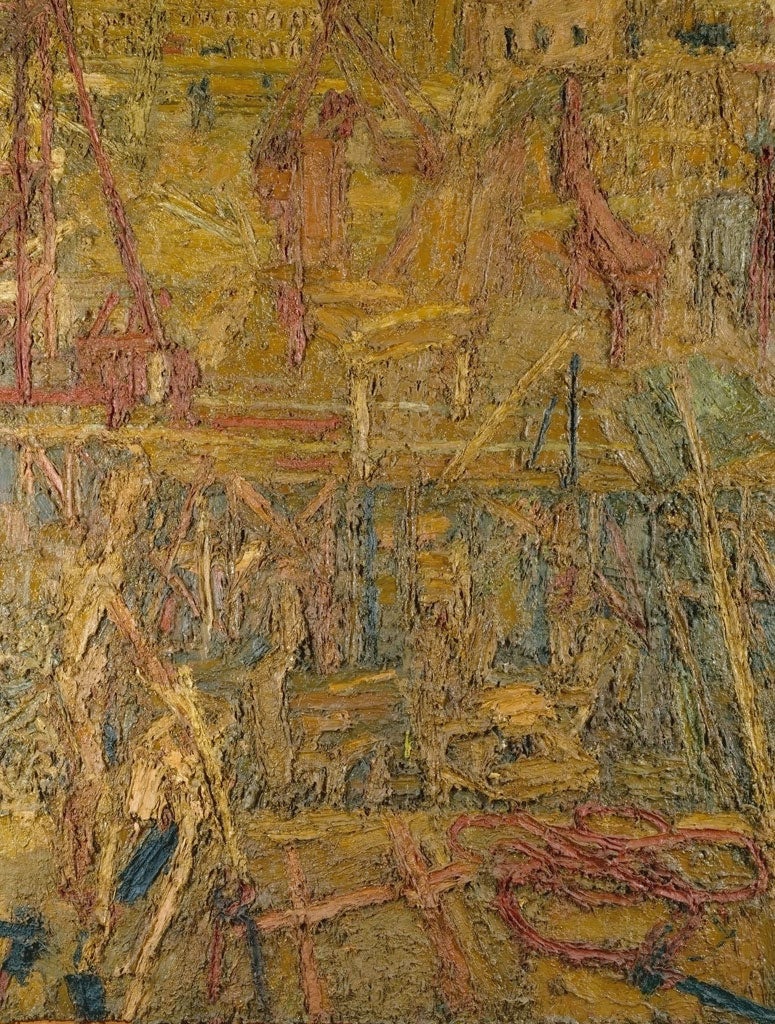Great Works: Oxford Street Building Site, 1959-60 (198cm x 153.6cm), Frank Auerbach
Tate Britain, London

This painting by a German Jew long resident in London at the time of its making seems to enact its own meaning. It is a little like a concrete poem – or a play whose writer has decided to cast himself as the principal actor. Illusionism in painting often consists of the creation of a perfectly smooth window through which the contrived reality of the painting can shine. Think of the magnificent landscapes of Claude Lorrain, for example. One mighty leap of the imagination, and we are deep inside that world. Nothing has caused us to hesitate at its painterly surface; almost nothing has caused us to ponder upon its physical fabrication, and to relate that act of making to the theme of the painting itself. It is quite otherwise here. Here making and theme feel inextricable.
Here the intense drama of the painting's fabrication lies at the level of the surface itself. We are caught short by it. Its heavy, sloppy globbiness slows down our looking; its intense, finger-smeary tactility draws us in. This is war-blasted London in the re-creation. Fifteen years have passed since the end of the Second World War, and the mighty task of re-making that which was almost pulverized into nothingness by the Luftwaffe is continuing at a seemingly feverish pace. London is fighting back. Oxford Street is fighting back. It is re-building itself, site by site.
This particular site of energetic refashioning is being imagined on a fairly rough-edged, rectangular piece of painted board. Board is good to paint on, as Auerbach and his fellow London painter Leon Kossoff have proven again and again. Board holds firm when it is nearly punished into submission by the painter. Board can resist, hold firm and steady, against repeated scrapings. Evidence of all this work, of all that has been lost and won, intensifies the dramatic potential of the painting itself. And so it is here. Auerbach worked on this series of paintings for at least a decade. His financial means were limited, and this fact explains in part the narrow range of colours that he is deploying here - these muddy, sludgy, merging, splurging duns, greys, russets, blacks, dingy greens, oranges, and even a flexy, snaky twist of off-red near its foot. And yet his means are perfectly sufficient unto the task. It is exactly what the task and the subject seem to demand.
This is an unpretty construction site that we are seeing here. Something is rising up again from destruction. Its crusty surface builds out, quite unevenly, towards the onlooker. The spread of those unevennesses, the way in which the painting is scored into to create the uprights, the diagonals, makes the painting's surface gleam and wink at us in odd, jewel-like ways. Parts of it look like rain-lashed puddles catching the light. Yes, there is more than a hint of sour London weather and mud-caked boots in this painting. The entire work looks labour-intensive, as the re-making of those buildings was undeniably labour-intensive. The entire surface looks like the precarious creation of a wall of built scaffolding, Meccano-like interlockings, attended upon by all the bits and pieces of machinery that would need to be in attendance – the wheelbarrow, the spade, the hoist. It is a tremendous flurry of semi-abstract mark-making.
In its less unquiet sequel, Oxford Street Building Site II, painted on canvas in that same year, recognizable details emerge more fully. Here, there seems to be an almost deliberate holding back, a conscious refusal to do much more than erect a wall of patterning that will stand for the mighty effort of re-construction. And yet the sheer physicality of its making seems to give the lie to that march towards abstraction, and so the two possibilities are held in balance. The cause of abstraction is helped by the fact that the picture plane looks flattened - in spite of the heavy, muddy texturing. The very earth itself seems to be rising up to counter the forces of destruction.
'Oxford Street Building Site I' is on display at Tate Britain, London
ABOUT THE ARTIST
Frank Auerbach (b 1931) came to Britain from Berlin as a child, in 1939. His parents died in a concentration camp. He has repeatedly painted the urban scenes of north London, and has made drawn portraits in ways that often remind us of the scaffolding in this Oxford Street scene.
Join our commenting forum
Join thought-provoking conversations, follow other Independent readers and see their replies
Comments